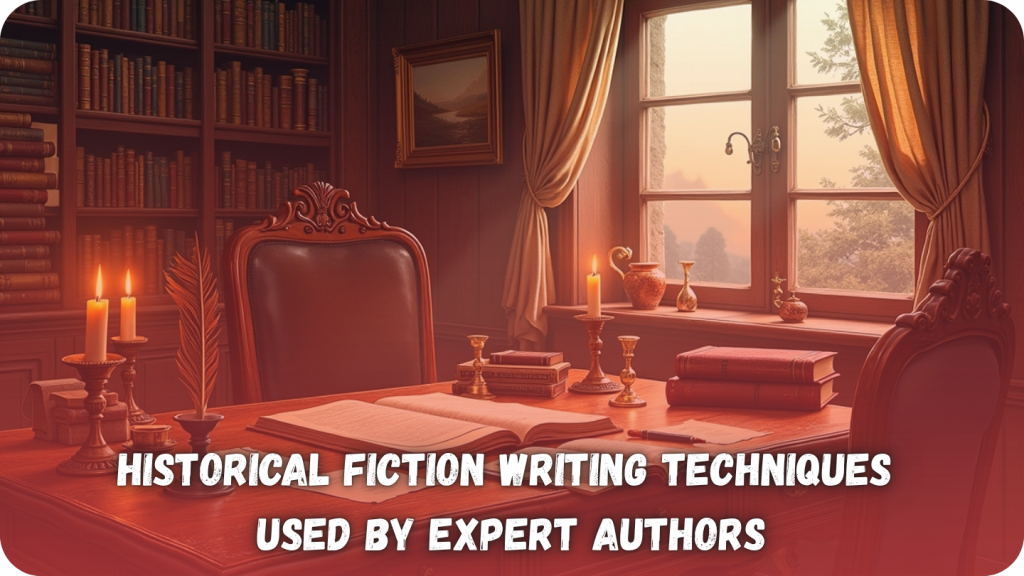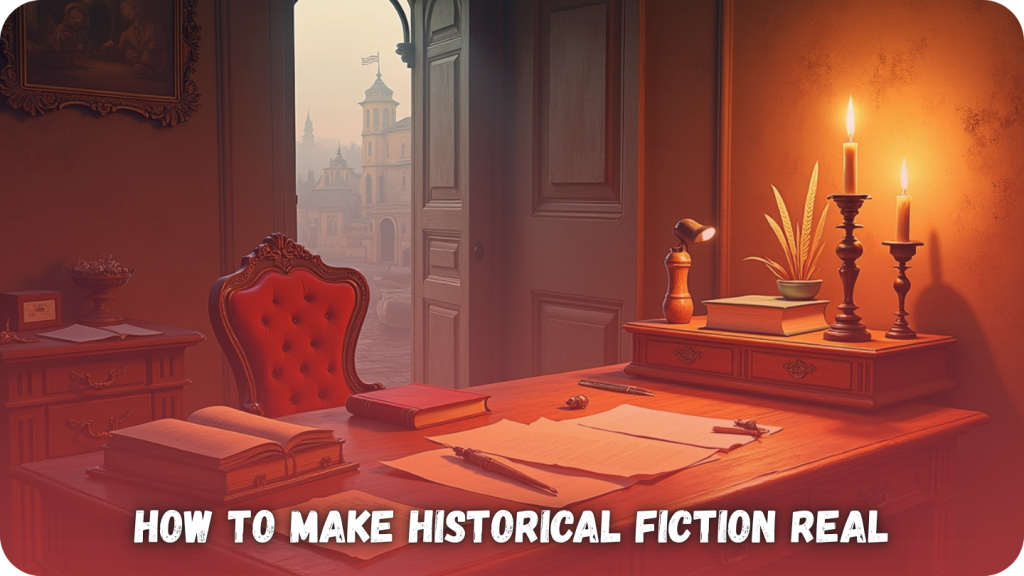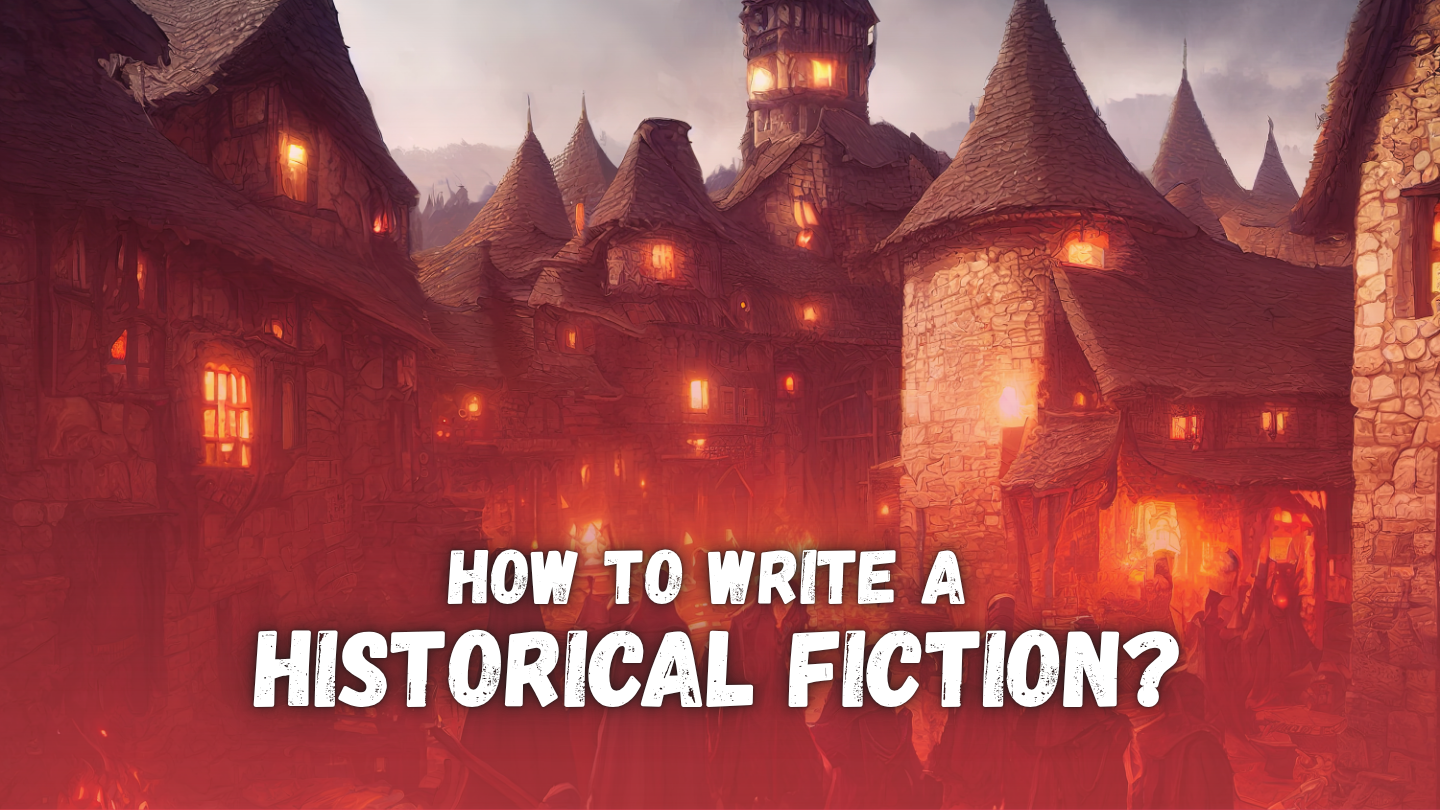I once read a diary entry from 1871 that mentioned nothing about war, politics, or power. It simply said, “The air smelled of apples today. I think he noticed me.” That one line held more truth than pages of recorded history.
If you want to write a historical fiction novel that lives beyond facts, start there. Start with the air. Start with how people noticed one another. The beauty of this genre is not in proving what happened. It’s in showing how it felt.
Most people don’t come to historical fiction for facts. They come for the feeling. They want to hear footsteps on old wooden floors and notice the way someone grips a letter before reading it. They look for stories that hold the weight of real lives, not ones that repeat what history has already told them. The past becomes real when you let the silence speak.
This guide is not filled with tricks. It is filled with care. You will learn how to write a historical fiction story that respects the past and reaches the present. If that matters to you, you are in the right place.

What Is Historical Fiction and How Does It Work?
Try walking through a place you have never seen, guided only by a voice that remembers how it used to feel. That is what historical fiction does. It lets the past move again, not as a list of events but as moments full of life.
To write a historical fiction story, you begin with curiosity. You ask what the world looked like at a certain time. Then you keep asking. What did people eat? What could they not say out loud? What would they give up to protect the ones they loved?
This genre does not rely on facts alone. It depends on what those facts mean. Writing historical fiction is about stepping inside a world that once was and allowing the reader to follow you in without needing an explanation.
So, what is historical fiction? It is a story shaped by research but carried by feeling. You stay true to time and place, but you also build something new within it. A voice. A path. A question worth following.
If you want to write a historical fiction novel that feels real, start by listening. History already has a heartbeat. Your job is to let it speak.
Tips for Writing Historical Fiction That Feels Authentic
The first time you try writing historical fiction, you might feel a kind of silence. Not the kind that comes from not knowing, but the kind that asks you to listen longer. Writing in this genre is not about showing what you’ve learned. It is about trusting what you’ve absorbed. Let’s look at the tips for writing historical fiction; these might help the process feel more honest and grounded.
Do Not Rush Your Research
Before you write a historical fiction story, spend time with the small things. Menus. Letters. Fabric. Sounds. Let the world form before the plot does. Facts are everywhere. Atmosphere is earned.
Keep Modern Language Out of the Dialogue
If a phrase feels too familiar, pause. Ask yourself if that voice could have existed in the time you’ve chosen. This small habit protects the mood more than anything else.
Create Characters Who Belong to Their Time
Historical fictional characters should not speak or think like people today. That does not mean they lack depth. It means their beliefs, fears, and values rise from the world around them.
Let Emotion Carry the Truth
Readers remember how something made them feel. A good story does not repeat a timeline. It uncovers what history left behind.
Avoid Using History as Decoration
A strong setting is not enough. The events of the time must shape the story. If your plot still works when moved to another century, something is missing.
Draw from The Best but Find Your Own Rhythm
Read the best historical fiction novel you can find. Notice how authors of historical fiction build silence into their scenes. Then close the book and write your own without copying the pattern.
Trust Slowness
Historical fiction rewards patience. There is no shortcut to understanding a time period. You are not just telling a story. You are remembering something the world forgot.
Let The World Answer Your Questions
If you wonder what came next in your scene, look back at the time itself. The answers are there. Let them come through the choices your characters make.
Characteristics of a Historical Fiction Story That Stands Out
If a story takes place in the past but feels flat or forced, it is just history dressed up. The stories that stay with readers are the ones that feel honest. They move with their own shape. They carry time in every detail. When you write a historical fiction story that works, the past doesn’t sit behind the characters. It moves with them.
- The story brings up parts of history people don’t often hear about
- Time and place affect how the characters think and react
- The world feels lived in without needing to be explained
- Every day life is shown through things like food, work, and weather
- The language sounds natural for the time, but is still easy to follow
- The events could not happen in any other century and still make sense
Crafting Strong Historical Fictional Characters
A woman steps into a room and says nothing. Her dress is clean, but her hands are rough. There is a story there. You can feel it before you know it. This is where strong characters begin.
To write a historical fiction story that stays with readers, you need more than names and backstories. You need people who move with the weight of their time. Their choices should not feel modern. Their reactions must come from the world they were born into.
When writing historical fiction, your characters must fit into the time without becoming tools for teaching. Let them live. Let them love badly. Let them hold onto pride or tradition even when it costs them everything.
They are not there to recite facts. They are there to carry feelings. Look at the best historical fiction novel you have read. The characters who stayed with you probably did not explain their time. They showed you what it meant to survive it.
Historical fictional characters are strongest when their needs press against the limits of their world. They ask for something small. A letter. A name. A chance. And somehow, it becomes everything.
This is what gives the story its shape. You do not need them to be loud. You need them to be true.
Your Historical Fiction Writing Guide from Start to Finish
There is no single right way to build a story from the past, but there are steps that help bring order to the process. Historical fiction asks for both imagination and structure. This guide gives you a clear path from first idea to finished manuscript.
Start with A Moment That Makes You Curious
Choose something to write a historical fiction, like a small from history. A rule, a death, a silence. Let it spark a question only fiction can answer.
Choose A Timeline with Real Change
Set your story during a time when something was shifting. It could be political, cultural, or personal. Movement gives your plot direction.
Map The Historical Facts Before Creating Scenes
Build a rough timeline of key real-world events. Know what’s happening in the background before you write your own foreground.
Build Your Chapters Around Turning Points, Not Dates
A good story moves through decisions, not calendars. Let each chapter follow a change in your character’s life.
Mix Research Days with Writing Days
Don’t do all your reading at once. Give your brain time to use what you learn. Move between history and story as you go.
Rethink Structure to Suit Your World
Some stories need letters. Others need dual timelines. Your structure should match the voice of your world.
Keep Track of What the Reader Knows
Each chapter should add something new. Avoid repeating the same facts or themes. Let the world grow as the story moves forward.
End with The Truth That Feels Earned
The final pages must belong to the world you built. Don’t solve things with logic that doesn’t fit the time. Stay with the world until it lets go of you.
This is not a formula. It is a rhythm. To write a historical fiction story that feels complete, you must stay close to both the story and the time.
When the Story Is Yours but the Words Are Not: Should You Work with a Ghostwriter?
You might know the time, the setting, the feeling behind it all. Maybe you have lived with this story for years. You see it clearly, but still cannot get the words right. That is not failure. It just means you may need support.
A ghostwriter does not take your story away. They listen to what you already know. Then they help you turn it into something full. Something finished. You still choose the moments. You decide how it feels. The ghostwriter brings shape and focus.
Writing historical fiction takes time you may not have. It takes a steady hand when the details feel overwhelming. You do not need to do it alone. Some writers start with outlines. Others bring pieces of scenes or scattered thoughts. That is enough to begin.
When the time comes to publish historical fiction, you want to be proud of every part. If you cannot write it on your own, it is still your story. The voice stays yours. The ghostwriter helps it land.
This is not about getting someone else to speak for you. It is about making sure your story reaches someone who will remember it.

Historical Fiction Writing Techniques Used by Expert Authors
Start with silence. Not in the room, but in the sentence. That pause where the reader leans in. Many of the best authors of historical fiction know that what is not said can be more powerful than any piece of research.
To write a historical fiction novel that carries depth, there are techniques beyond research and realism. These methods are not rules. They are habits shaped through practice. Below are some of the historical fiction writing techniques through which expert writers bring richness and tension to every scene.
1. Contrast Private Thought With Public Behavior
In many best seller historical novels, characters must live two lives. What they show in front of others is shaped by pressure. What they feel inside is where the real story lives.
2. Use Sensory Memory To Anchor The Reader
Instead of explaining where we are, let a taste or a sound do the work. A spoon hitting a metal bowl. Mud clinging to the hem of a dress. These are the details that hold the scene in place.
3. Layer Emotion Beneath Historical Detail
Facts should not sit alone. A date should carry loss. A law should create fear. Expert authors of historical fiction never separate history from feeling.
4. Create Tension With What The Reader Knows
Let the reader stay one step ahead. If a war is coming and your character has no idea, the quiet days feel sharper.
5. Let The Setting Carry A Metaphor
A ruined wall. A frost that will not lift. Natural elements can mirror emotional conflict. The best authors use place to reflect what cannot be said out loud.
6. Break The Scene With Silence Or Interruption
A pause. A glance. A door opening before the sentence ends. These small moves change the rhythm and build energy without needing action.
When you write a historical fiction novel that uses these techniques, you move beyond information. You create experience. That is what the reader remembers.
Learn from the Best: Authors of Historical Fiction and Their Best Seller Historical Novels
You can read all the guides you want, but nothing teaches you how to write a historical fiction novel like reading one that stays with you for years. Not for its facts, but for how it made you feel. The best authors of historical fiction don’t just recreate the past. They open it. They show you what it meant to live inside a different time, with all the weight that comes with it.
If you want to write a historical fiction story that holds meaning, spend time with the authors who have already done it with care. These books are not only best sellers. They are proof that history can be told with honesty and feeling.
Hilary Mantel – Wolf Hall
This one moves slowly, but on purpose. You follow Thomas Cromwell through the sharp turns of power in Henry VIII’s court. Mantel doesn’t explain history. She lets you sit with it. Her characters think like real people, not figures from a textbook.
Colson Whitehead – The Underground Railroad
You might expect a straight historical novel. What you get is something deeper. Whitehead blends fact with invention, not to escape truth, but to push it forward. His version of the past makes you feel it in your gut.
Toni Morrison – Beloved
This is not an easy read. And that’s the point. Morrison doesn’t just talk about what happened. She writes about what stays. Beloved is about memory, love, and pain that outlives the event. Every sentence feels like it matters.
Yaa Gyasi – Homegoing
Two sisters. Two lines. One history. You move from Ghana to the American South and keep going. Each chapter is its own life. Gyasi writes with care and weight, but never with distance. You stay close to the characters all the way through.
Anthony Doerr – All the Light We Cannot See
A girl and a boy on opposite sides of World War II. The chapters are short. The feeling is not. Doerr lets the smallest things carry the biggest meaning. A shell. A radio. A light. It’s quiet, but it cuts deep.
Isabel Allende – The House of the Spirits
If you want to see how memory and politics live side by side, this is the one. Allende blends history with family and spirit in a way that feels personal, even when the world around them is falling apart.
You don’t need to copy these writers. But you can learn from how they listen to history. They don’t rush. They don’t explain too much. They write like the past still matters. That’s the key.

How to Make Historical Fiction Real: Depth, Care, and Connection
Dig Deeper Than Dates: Finding the Life in the Past
Most writers start research to write a historical fiction with big battles and famous names. To make history breathe, chase the tiny, overlooked things.
Look for:
- Local papers and old ads
- Shopping lists or restaurant menus
- Birth/death notices in community bulletins
- Handwritten recipe books or personal diaries
These everyday fragments capture a time’s true rhythm better than any official record.
Walking the Line: When Fact Meets Story
Worrying about perfect accuracy can freeze you. History matters, but you’re writing a story.
Test your choices:
- Does this change serve the heart of the tale?
- Could it disrespect real people or events?
- Can I note liberties taken in an author’s note?
Aim for respect, not rigidity. Keep the story moving while honoring the truth.
Making the Past Feel Real (Not Modern)
The trick? Make historical characters understandable without making them contemporary.
How:
- Focus on timeless wants: safety, love, belonging.
- Don’t judge them by today’s rules.
- Present historical norms plainly, no need to excuse or erase.
Let readers understand the distance, not just judge it.
Mixing Your Characters with Real History
Want your fictional people to brush against real events? It adds weight, but handle with care.
Try:
- Making them witnesses, not key players in major moments.
- Letting them affect small, side stories, not change history.
- Using invented letters or encounters to show personal reactions to big events.
This keeps realism without rewriting the record.
Braiding Timelines: Past & Present
Linking two eras (past and “now”) is popular. It shows how history echoes.
Do it well:
- Give each timeline its own strong, complete journey.
- Connect them through themes (loss, courage, secrets), not just plot tricks.
- Use physical objects (a ring, a diary, a house) to bridge the gap.
Readers love the puzzle and emotional depth this creates.
Writing History Responsibly
Tackling real pain, injustice, or violence from the past demands thought.
Ask yourself:
- Is this my story to tell? Am I the right voice?
- Can I avoid harmful stereotypes or cheap drama?
- Am I honoring real experiences, not just using them for plot?
Writing with care means your book adds to the conversation, not the hurt.
Sharing Your Work: Who Helps Most?
Before publishing, fresh eyes spot what you’ve missed.
Seek out:
- Experts specializing in your exact time/place.
- Beta readers who devour historical fiction.
- Sensitivity readers, if you’re writing about experiences outside your own.
Tough feedback stings, but it makes the final story truer and deeper.
Getting Your Story Published in Today’s Market
Before your book ever reaches a shelf, it has to pass through real people. A tired assistant on their third cup of coffee. A literary agent looking for one clear voice in a pile of five hundred. A small publisher reading late into the night because they believe in books more than schedules.
One of the most important writing historical fiction tips is to remember that a polished manuscript alone isn’t enough. If you want to publish historical fiction at Arkham House Publishers today, you need more than a finished draft. You need focus, timing, and a strategy that resonates with the world we live in right now.
Know Who Your Readers Are
Before sending your story out, ask who it is for. Does your story speak to readers of literary fiction, book club communities, or fans of a specific era? A clear audience gives your work direction.
Understand What Publishers Expect
Research publishers like Arkham House Publishers and agents who have worked with authors of historical fiction. Look at the kinds of books they represent. See how they talk about character, time period, and tone. Tailor your query with that in mind.
Write A Strong Pitch
When you write a historical fiction pitch, it is not about the entire plot. It is at the heart of the story. Keep it clear, honest, and brief. Make sure it sounds like you and not a summary from the back of a textbook.
Polish The First Few Chapters
Many submissions get stopped at page three. Your opening must hold weight. It must sound like it belongs to its time without slowing down the reader. Let your voice come through early.
Decide Between Traditional and Independent Paths
Some writers want the support of a publishing house. Others prefer control through self-publishing. Both are valid. What matters most is the intention you bring to the process. Take time to research both.
Get Feedback Before Sending Your Manuscript
A few trusted readers can save your book from going out too early. Ask for honest thoughts. Revise with care. Then let it go.
To write a historical fiction novel is to offer something lasting. To publish it is to release it into a world that needs new stories told with clarity and heart. Your job now is to give your book its best chance.
Final Thoughts
There is a certain quiet that comes after you close a good book. The kind where the room feels heavier, even though nothing has changed. That is the kind of stillness you aim for when you write a historical fiction novel. Not noise. Not a spectacle. Just a story that stays behind.
This genre asks for something many others do not. It asks for patience. It asks you to carry voices that no longer speak. To look at the lives that were missed or rewritten and bring them forward with care. That is why writing historical fiction is not just creative work. It is personal work.
You do not need to be a scholar. You do not need to get every fact perfect. What matters most is that you listen. That you follow the emotions that arise from the time you chose. That you stay true to what you found in the quiet.
As you move forward with your story, return to the authors of historical fiction who shaped your thinking. Let the best seller historical novels teach you pacing, silence, and depth. Let the characters you create surprise you. Let the process remain yours.
And when the time comes to publish historical fiction, do it with the same care you gave the first sentence. There is no rush. No one path. Only your voice and the truth it chooses to carry.
You are not writing to explain what was. You are writing to show what it felt like. That is what makes this work worth doing. That is what makes it matter.





